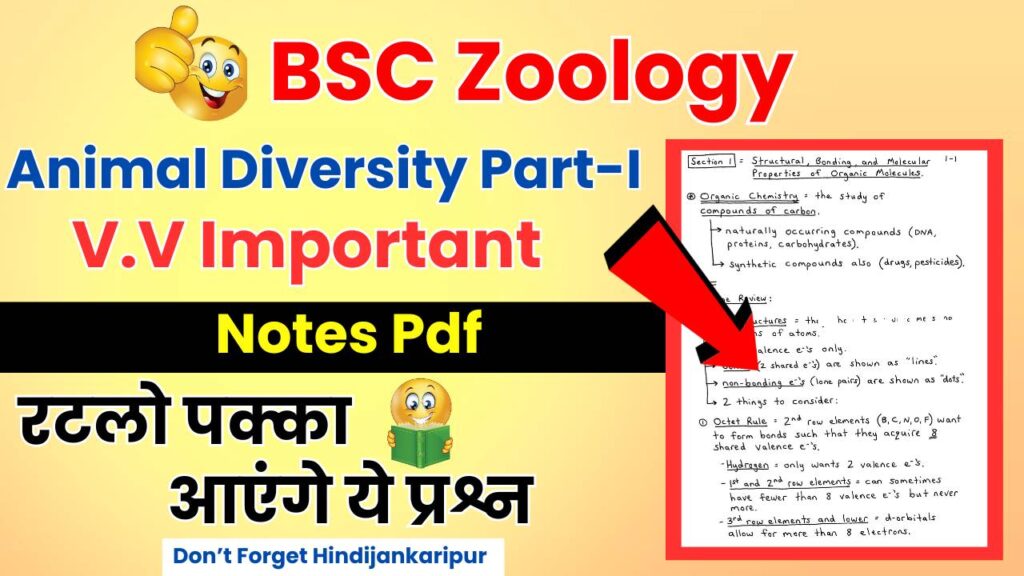Do you want to know about Bsc Zoology Animal Diversity Part-I Notes? Welcome friends, in this article we will tell you everything about Zoology Animal Diversity Notes, as you know Zoology is a very mind-intensive subject.

So in this article we have collected Bsc Zoology Animal Diversity Part-I Notes Information which will help you in studying, if you memorize the notes mentioned in this article once, then you can understand that 60% of the syllabus will be covered.
So to get the information of complete list of Bsc Zoology Animal Diversity Part-I Notes, read this article till the end.
Contents
Bsc Zoology Animal Diversity Part-I Notes
| Subject | Bsc Zoology Animal Diversity Part-I Notes |
| Provide by | Hindijankaripur |
| Official Site | Hindijankaripur.com |
| Telegram | https://t.me/studentcafeindia |

Invertebrates
Protozoa
Protozoa are unicellular eukaryotic organisms with a protoplasmic level of organization. They are heterotrophs that ingest their food and are known for their locomotion using various organelles. Protozoa play a significant role in diseases and have economic importance due to their impact on agriculture and human health.
Porifera
Porifera, commonly known as sponges, are multicellular organisms with a porous body and a simple canal system. They are primarily marine and exhibit a range of feeding mechanisms, including filter feeding. Their skeleton is made up of spicules, which can be composed of silica or calcium carbonate.
Coelenterates
Coelenterates, or Cnidaria, are characterized by their radial symmetry, presence of nematocysts, and a body cavity called a coelenteron. They exhibit polymorphism and are important for the formation of coral reefs, which are crucial for marine biodiversity.
Platyhelminthes
Platyhelminthes, or flatworms, are acoelomate, dorsoventrally flattened animals with bilateral symmetry. They include both free-living and parasitic species, with some causing significant diseases in humans and animals. They possess protonephridia and flame cells for excretion.
Nematodes
Nematodes, or roundworms, are pseudocoelomate, unsegmented worms with a cylindrical body covered by a cuticle. They are known for their parasitic adaptations and medical importance, as many species are capable of causing diseases in humans and other animals.
Molluscs
Molluscs are a diverse group with characteristics such as a muscular foot, shells, and torsion. They have various feeding mechanisms and play a significant role in ecosystems. Some molluscs are economically important due to their use as food and for pearl production.
Arthropods
Arthropods are the largest phylum in the animal kingdom, characterized by jointed legs and segmented bodies. They exhibit various respiratory mechanisms and undergo metamorphosis during development. Insects, a subgroup of arthropods, provide benefits but also can be pests, necessitating control measures.
Annelida
Annelids are segmented worms with a coelom and exhibit metamerism. They have various systems for feeding and respiration. Earthworms and leeches, which are part of this phylum, have economic importance due to their roles in soil fertility and medicine.
Echinodermata
Echinoderms are characterized by their radial symmetry, water vascular system, and larval forms. They are exclusively marine and have a unique system for locomotion and feeding.
Protochordates
Protochordates include Urochordates, Cephalochordates, and Hemichordates. They are characterized by the presence of a notochord at some stage in their life cycle and are considered to be closely related to vertebrates.
Chordates
Chordates are distinguished by their notochord, dorsal nerve cord, pharyngeal slits, and post-anal tail. This phylum includes both invertebrate and vertebrate animals.
Vertebrates
Pisces
Fishes are aquatic vertebrates with gills and fins. They are classified into cartilaginous and bony fishes and have various adaptations for aquatic life. Fishes are economically important, especially in aquaculture.
Amphibians
Amphibians are characterized by their ability to live both in water and on land. They undergo metamorphosis from a larval stage to an adult, and some species exhibit parental care.
Reptiles
Reptiles are ectothermic vertebrates with scales. They include snakes, lizards, turtles, and crocodiles. The mechanism of snake biting and the distinction between poisonous and non-poisonous snakes are important for understanding reptilian diversity.
Aves
Birds are warm-blooded vertebrates with feathers and wings. They exhibit flight adaptations and some species migrate seasonally. The study of birds includes their classification and the physiological mechanisms behind their flight and migration patterns.
Mammals
Mammals are characterized by the presence of mammary glands, hair, and a neocortex. They are classified into monotremes, marsupials, and placental mammals. Mammals show a wide range of adaptive radiation according to their habitats.
Additional Topics
Coelom Formation
The coelom is a fluid-filled body cavity that forms within the mesoderm during embryonic development. It plays a crucial role in the organization of internal organs and systems in triploblastic animals.
Evolution of Heart in Animals
The heart has evolved in complexity from simple tubular structures to the four-chambered heart found in mammals and birds. This evolution reflects the increasing demands of metabolism and oxygen transport in more active and complex organisms.
Wildlife and Biodiversity in Pakistan
Pakistan, particularly Balochistan, has a rich diversity of wildlife. Conservation efforts are important to maintain this biodiversity, and understanding the distribution, status, and management of wildlife is crucial for its preservation.
Also Read: BSC Zoology Animal Diversity part-i MCQ
We hope that with the help of this article you have got information about Bsc Zoology Animal Diversity Part-I Notes.
Friends, how did you like this post, please tell us in the comment section and if you have any questions, feel free to ask us in the Comment Box. If you find this post useful, please share it with others.